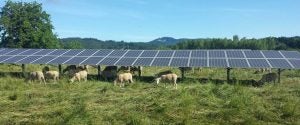Farmers have relied upon the sun for income since the earliest of times, and with interest in renewable energy high on the minds of Americans, opportunities for farmers to continue this tradition abound. Land in the right location could provide income opportunities by way of leases to solar farms, not dissimilar to those traditionally worked out with coal, oil, and gas companies. The key to making this work hinges upon doing one’s homework as opportunities and rates depend, as always, on location, location, location.
Harvesting the sun
The term “solar farm” refers to large, utility-scale stretches of ground where photovoltaic (PV) cells are constructed into panels and used to feed electricity into the grid. Whereas rooftop solar panels are designed to supply enough energy for the house on which they’re placed, solar farms can produce enough electricity to supply thousands of homes while generating nearly no pollution. Recent research out of Oregon State University points to farmlands as being the most productive spots for solar power. That study, published in the journal Scientific Reports, finds that if even less than 1 percent of agricultural land was converted to solar panels, it would be sufficient to fulfill global electric energy demand.
The technology behind the panels themselves is in and of itself an evolving field, with innovations occurring daily. Some PV panels are set into static positions to catch solar rays as the Earth rotates through the morning into night, while others have mobile panels that actually follow the sunlight east to west throughout the day.
Currently, solar farm developers need a minimum of 2.5 acres of panels in high-intensity sun areas to produce one megawatt of electricity, while more acres of panels might be needed in areas with moderate sun access. Across the country, a one-megawatt system typically requires six acres for 3,000 to 4,000 individual panels and may cost upwards of $3 million to build. Mitigating factors, of course, include latitude, shade by way of trees and mountains, and seasonal differences. As one might expect, Arizona property would be preferable to say, Alaska.
One megawatt equals one million watts, which is approximately the amount needed to power 650 residential homes per day. California is the top solar farming state in the U.S. with enough energy to power more than a million homes. Meanwhile, North Carolina, Nevada, Massachusetts, Arizona, and New Jersey are producing enough to handle up to 50,000 homes, and New York, Texas, Hawaii and New Mexico are in the under-25,000 homes category.

Landowners on call
In 2018, total solar output for the U.S. contributed 1.6 percent of the nation’s energy with 67 billion kWh. But developers and government officials alike are hungry for more. Tax credits for participating in solar farming vary across the states, so interested landowners should check with their local Extension Office. Meanwhile, the opportunities for farmers and landowners to participate are booming. Much like any other agricultural land lease, the value of the ground will depend on many factors. Some states and private corporations such as Wal-Mart and Google are lending support to solar energy by buying more from renewable producers.
Although, as with all land-lease deals, there are no cookie-cutter guarantees, so consider recent averages as examples. A 10-acre solar farm near a substation outside an urban area might command $2,000 per acre rent for the landowner, but more rural areas near a substation might be over $1,000 for the same size tract. Larger tracts over 100 acres might rent between $300 and $500 per acre, as many do across Texas, with an average nearer $500 across the southeast. Obviously some of the factors involved in the developers’ side will be cost of set-up and length of the lease, which is why many agreements are 30-years or more. Proximity to substations and power customers are likewise as important a consideration as the sunlight itself.
“There’s an old adage that agriculture can overproduce anything. That’s what we found in electricity, too,” said Chad Higgins, an associate professor in Oregon State’s College of Agricultural Sciences. “There’s a huge potential for solar and agriculture to work together to provide reliable energy.”
The State of New York has reported incredible interest in the sector, with 575 percent growth in the past four years. Typical plots for solar farms there range from 10 to 30 acres. New York Gov. Andrew Cuomo’s initiative, NY-Sun, aims to add more than 3GW of installed solar capacity to that state by 2023, meaning farmers are being approached even now.
Issues to consider include property taxation, and landowners need to check with their counties to determine whether these panels might be taxes as improvements or not. Also, consider the impact of run-off water as having thousands of panels lined up in rows will most certainly shed precipitation.
Interested landowners might start by contacting their own utility company or electrical cooperative to see if they have either interest or contact information for solar farm developers. A quick online search will generate a healthy number of companies actively seeking land to develop. Farmers and ranchers have long partnered with the carbon industry in terms of energy production on agricultural land, and coming soon to a field near you, the solar industry could be next.
Brian Boyce is an award-winning writer living on a farm in west-central Indiana. You can see more of his work at www.boycegroupinc.com.



